|
Tobacco use is the leading preventable cause of death in the United
States. The impact of tobacco use in terms of morbidity and mortality to
our society is staggering. Smoking kills an estimated 443,000
people each year, is known to cause of about 25 diseases, and harms nearly every organ of the body.
Quitting smoking has immediate as well as long-term benefits for you and
your loved ones. Breathing secondhand smoke (SHS) causes heart disease
and lung cancer in adults and increased risks for sudden infant death
syndrome, acute respiratory infections, middle-ear disease, worsened
asthma, respiratory symptoms, and slowed lung growth in children.
We have made progress in reducing tobacco use among youth; however,
far too many young people are still using tobacco, and most new smokers
today with be children and teenagers. Currently, more than
600,000 middle school students and 3 million high school students smoke
cigarettes. Rates of decline for cigarette smoking have slowed in the
last decade and rates of decline for smokeless tobacco use have stalled
completely.
Awareness of alcohol use and misuse on college campuses is not new. Research indicates that
almost 80% of
college students drink; of those, half engage
in heavy episodic drinking. Excessive alcohol intake among college
students is associated with a variety of adverse consequences: fatal and
nonfatal injuries; alcohol poisoning; blackouts; academic failure;
violence, including rape and assault; unintended pregnancy; sexually
transmitted diseases, including HIV/AIDS; property damage; and
vocational and criminal consequences that could jeopardize future job
prospects. Excessive binge drinking not only impacts the
abuser, but everyone around them as well. Fellow students experience secondhand consequences ranging
from disrupted study and sleep to physical and sexual assault.
Furthermore, the schools they attend expend valuable resources to deal
with institutional and personal consequences of their behavior.
Chronic disease is not a genetically "hard-wired"
destiny. Controllable risk factors such as tobacco and alcohol
(along with
the diseases they incur), are a matter of choice. Remember,
if it's predictable, it's preventable!
|
- The Basics:
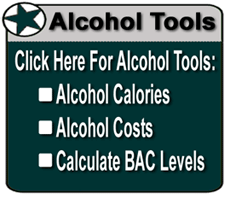
- Alcohol:
- Ethyl alcohol, or ethanol, is an
intoxicating ingredient found in beer, wine, and liquor.
-
Alcohol is produced by the fermentation of yeast, sugars,
and starches.
- It is a central nervous system depressant
that is rapidly absorbed from the stomach and small
intestine into the bloodstream.
- Alcohol is
metabolized in the liver by enzymes; however, the liver can
only metabolize a small amount of alcohol at a time, leaving
the excess alcohol to circulate throughout the body.
- Blood Alcohol Concentration:
- Blood alcohol content (BAC), also called
blood alcohol concentration, is most commonly used as a
measurement of alcohol intoxication for legal or medical
purposes.
- Blood alcohol concentration is usually
expressed as a percentage of alcohol (ethanol) in the blood.
- Example, a BAC of 0.10 means that 0.10%
(one tenth of one percent) of a person's blood, by volume
(usually, but in some countries by mass), is alcohol.
- See Factors that Influence BAC below.
- Proof:
- In the United States, alcoholic proof is
defined as twice the percentage of the ABV (Alcohol By
Volume). Example, a product with 40% alcohol by volume would
be 80 proof.
- Standard Drink:
- Used as a measurement standard; an
alcoholic beverage that is equal to 14.0 grams (0.6 ounces)
of pure alcohol. Generally, this amount of pure alcohol is
found in
- 12-ounces of beer.
- 8-ounces of malt liquor.
- 5-ounces of wine.
- 1.5-ounces or a “shot” of 80-proof
distilled spirits or liquor (e.g., gin, rum, vodka, or
whiskey).
- Alcohol contains 7 calories per 1 gram.
- Alcohol Abuse:

- A pattern of drinking that results in
harm to one’s health, interpersonal relationships, or
ability to work. Manifestations of alcohol abuse can
include:
- Failure to fulfill major
responsibilities at work, school, or home.
- Drinking in dangerous situations,
such as drinking while driving or operating machinery.
- Legal problems related to alcohol,
such as being arrested for drinking while driving or for
physically hurting someone while drunk.
- Continued drinking despite ongoing
relationship problems that are caused or worsened by
drinking.
- Long-term alcohol abuse can turn into
alcohol dependence.
- Alcoholism:
- A chronic disease characterized by
dependency on alcohol, also referred to as alcohol
addiction. The signs and symptoms of alcohol dependence
include
- A strong craving for alcohol.
- Continued use despite repeated
physical, psychological, or interpersonal problems.
- The inability to limit drinking.
- Binge Drinking:
- According to the National Institute
on Alcohol Abuse and Alcoholism, binge drinking is
defined as a pattern of alcohol consumption that brings the
blood alcohol concentration (BAC) level to 0.08% or more.
- This pattern of drinking usually
corresponds to 5 or more drinks on a single occasion for men
or 4 or more drinks on a single occasion for women,
generally within about 2 hours.3
- Intoxication:
- Also known as drunkenness or inebriation,
refers to the physiological state induced by the consumption
of ethyl alcohol (ethanol), which builds up in the
bloodstream faster than it can be metabolized by the liver.
- Common
symptoms include slurred speech, euphoria, impaired balance,
loss of muscle coordination (ataxia), flushed face,
dehydration, reddened eyes, reduced inhibition, and erratic
behavior.
- Legal Limit:
- The legal limit for drinking is the
alcohol level above which an individual is subject to legal
penalties (e.g., arrest or loss of a driver's license).
- Legal limits are measured using either a
blood alcohol test or a breathalyzer.
- All states in the United States have
adopted 0.08% (80 mg/dL) as the legal limit for operating a
motor vehicle for drivers aged 21 years or older. However,
drivers younger than 21 are not allowed to operate a motor
vehicle with any level of alcohol in their system.
- Legal limits do not define a level below
which it is safe to operate a vehicle or engage in some
other activity. Impairment due to alcohol use begins to
occur at levels well below the legal limit.
- Effects of Alcohol on the Body (an
Overview):
- Drinking too much – on a single occasion or over time – can
take a serious toll on your health. Here’s how alcohol can
affect your body:
- Brain:
- Alcohol interferes with the brain’s communication
pathways, and can affect the way the brain looks and
works.
- These disruptions can change mood and behavior, and
make it harder to think clearly and move with
coordination.
- Heart:
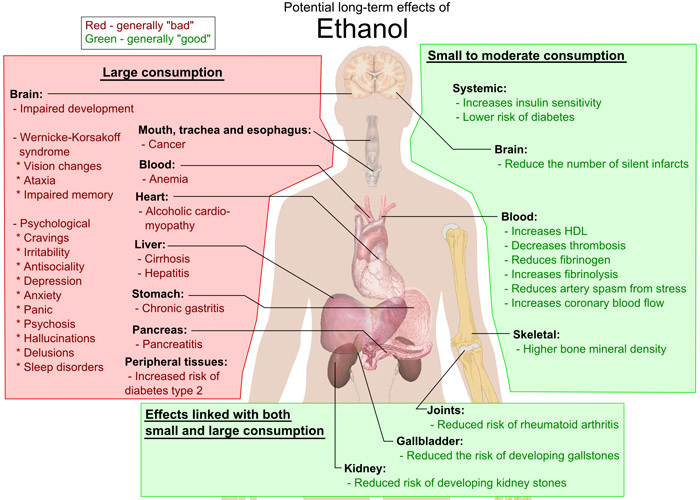
- Drinking a lot over a long time or too much on a
single occasion can damage the heart, causing problems
including:
- Cardiomyopathy – Stretching and drooping of
heart muscle
- Arrhythmias – Irregular heart beat
- Stroke
- High blood pressure (Some research also shows that
drinking moderate amounts of alcohol may protect
healthy adults from developing coronary heart
disease).
- Liver:
- Alcohol is metabolized in the liver.
- Heavy drinking takes a toll on the
liver, and can lead to a variety of problems and
liver inflammations including:
- Steatosis, or fatty liver
- Alcoholic hepatitis
- Fibrosis
- Cirrhosis
- Pancreas:
- Alcohol causes the pancreas to produce toxic
substances that can eventually lead to pancreatitis, a
dangerous inflammation and swelling of the blood vessels
in the pancreas that prevents proper digestion.
- Cancer:
- Drinking too much alcohol can increase your risk
of developing certain cancers, including cancers of the:
- Mouth
- Esophagus
- Throat
- Liver
- Breast
- Immune System:
- Drinking too much can weaken your immune system,
making your body a much easier target for disease.
- Chronic drinkers are more liable to contract
diseases like pneumonia and tuberculosis than people who
do not drink too much.
- Drinking a lot on a single occasion slows your
body’s ability to ward off infections – even up to 24
hours after getting drunk.
- Fetal Alcohol Spectrum Disorders
(FASDs):
- Fetal alcohol spectrum disorders (FASDs) are a group of
conditions that can occur in a person whose mother drank alcohol
during pregnancy.
- These effects can include physical problems and problems
with behavior and learning. Often, a person with an FASD has a
mix of these problems.
- Different terms are used to describe FASDs, depending on the
type of symptoms.
- Fetal Alcohol Syndrome (FAS):
- FAS represents the severe end of the FASD spectrum.
- People with FAS might have:
- Abnormal facial features, growth problems, and
central nervous system (CNS) problems.
- Problems with learning, memory, attention span,
communication, vision, or hearing. They might have a
mix of these problems.
- Often have a hard time in school and trouble
getting along with others.
- Alcohol-Related Neurodevelopmental Disorder
(ARND):
- People with ARND might have:
- Intellectual disabilities and problems with
behavior and learning.
- They might do poorly in school and have
difficulties with math, memory, attention, judgment,
and poor impulse control.
- Alcohol-Related Birth Defects (ARBD):
- People with ARBD might have:
- Problems with the heart, kidneys, or bones or
with hearing.
- They might have a mix of these.
- Alcohol Poisoning:
- As a central nervous system depressant,
alcohol depresses nerves that control involuntary actions such
as breathing and the gag reflex (which prevents choking).
- A fatal dose of alcohol will eventually stop
these functions.
- Critical signs and symptoms of Alcohol
Poisoning include:
- Mental confusion, stupor, coma, or person
cannot be roused.
- Vomiting, or vomiting while unconscious.
- Seizures.
- Slow breathing (fewer than eight breaths
per minute).
- Irregular breathing (10 seconds or more
between breaths).
- Hypothermia (low body temperature),
bluish skin color, paleness.
- All of the above signs or symptoms require a
911 call.
- Common myths associated with sobering up
include:
- Drinking black coffee.
- Taking a cold bath or shower.
- Sleeping it off, or walking it off.
- Factors that
Influence Blood Alcohol Concentration:

- Food and Bubbles:
- Absorption of alcohol is faster when the
stomach is empty; the empty stomach allows rapid passage of
the alcohol into the small intestine, where absorption is
most efficient.
- Carbonated beverages (e.g. mixed drinks
or champagne) relax the pyloric valve increasing the rate of
absorption of alcohol.
- The pyloric valve is the opening form
the stomach into the small intestine.
- Body Weight:
- Greater body weight provides a
greater volume in which alcohol can be distributed.
- This means a larger person will be less
affected by a given amount of alcohol than a smaller person
would be. However, see Body Fat below.
- Body Fat:
- Alcohol is more soluble in water than in
fat.
- This means that tissues rich in water,
like muscle, take up more alcohol than do tissues rich in
fat.
- Conversely, more of the alcohol
will stay in the blood stream of a person with a larger
amount of fat, meaning that person's blood alcohol
concentration (BAC) will rise faster.
- Gender:
- Traditionally, men have more water and
less fat in their body composition, which means the alcohol
will be more diluted.
- Females, on average, have a smaller body
mass and a higher proportion of body fat than do males,
resulting in higher BACs after consuming the same amount of
alcohol as a man
- Females also may have a lower activity of
the alcohol-metabolizing enzyme alcohol dehydrogenase (ADH)
in the stomach; therefore, more of the ingested alcohol
reaches the blood.
|
|
Tobacco: Basic Training |
 |
|
- The Basics of Tobacco:
- There are more than 4,000 chemicals found in the
smoke of tobacco products.
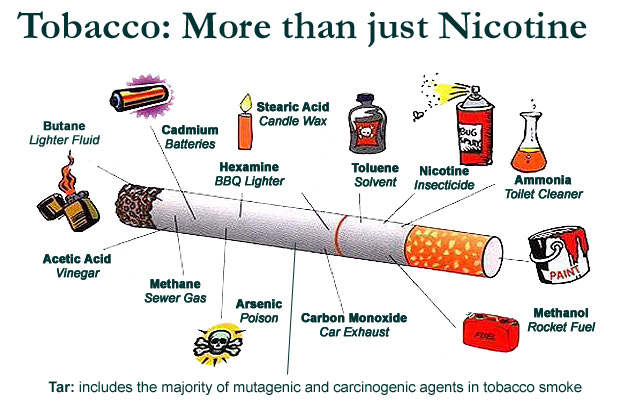
- Of these, nicotine, first identified in the early
1800s, is the primary addictive ingredient in tobacco.
- The cigarette is a very efficient and highly
engineered drug delivery system.
- By inhaling tobacco
smoke, the average smoker takes in 1–2 mg of nicotine
per cigarette.
- When tobacco is smoked, nicotine rapidly
reaches peak levels in the bloodstream and enters the
brain.
- A typical smoker will take 10 puffs on a
cigarette over a period of 5 minutes that the
cigarette is lit: 1½ packs (30 cigarettes) daily
gets 300 "hits" of nicotine to the brain each
day.
- In those who typically do not inhale the
smoke, such as cigar and pipe smokers and smokeless
tobacco users, nicotine is absorbed through the mucosal
membranes and reaches peak blood levels and the brain
more slowly.
- Immediately after exposure to nicotine,
there is a "kick" caused in part by the drug’s
stimulation of the adrenal glands and resulting
discharge of epinephrine (adrenaline).
- The rush of
adrenaline stimulates the body and causes an increase in
blood pressure, respiration, and heart rate.
- Nicotine Addiction:
- Cigarette smoking produces a rapid distribution of
nicotine to the brain, with drug levels peaking within
10 seconds of inhalation.
- Because smokeless tobacco is placed on or near a
mucous membrane, nicotine levels rise rapidly as
well.
- Nicotine activates reward pathways, the brain
circuits that regulate feelings of pleasure, as it increases levels of the
neurotransmitter dopamine in these reward circuits.
- Dopamine is a key brain chemical involved in
mediating the desire to consume drugs,.and is
thought to underlie the pleasurable sensations
experienced by many smokers.
- For many tobacco users, long-term brain changes
induced by continued nicotine exposure result in
addiction.
- However, the acute effects of nicotine
dissipate quickly, as do the associated feelings of
reward, which causes the smoker to continue dosing
(using tobacco)
to maintain the drug’s pleasurable effects and
prevent withdrawal.
- Nicotine withdrawal symptoms
include irritability, craving, depression, anxiety,
cognitive and attention deficits, sleep
disturbances, and increased appetite.
- These symptoms
may begin within a few hours after the last
cigarette, quickly driving people back to tobacco
use.
- Symptoms peak within the first few days of
smoking cessation and usually subside within a few
weeks. For some people, however, symptoms may
persist for months.
- Although withdrawal is related to the
pharmacological effects of nicotine, many behavioral
factors can also affect the severity of withdrawal
symptoms.
- Factors such as the feel, smell,
and sight of a cigarette and the ritual of
obtaining, handling, lighting, and smoking the
cigarette are all associated with the pleasurable
effects of smoking and can make withdrawal or
craving worse.
- Nicotine replacement therapies
such as gum, patches, and inhalers may help
alleviate the pharmacological aspects of withdrawal;
however, cravings often persist.
- Behavioral therapies can help
smokers identify environmental triggers of craving
so they can employ strategies to prevent or
circumvent these symptoms and urges.
- Tobacco, Advertising and Promotion:

- Tobacco companies spend more than a million dollars
an hour in this country alone to market their products.
This report concludes that tobacco product advertising
and promotions still entice far too many young people to
start using tobacco.
- The tobacco industry has stated that its marketing
only promotes brand choices among adult smokers.
Regardless of intent, this marketing encourages underage
youth to smoke. Nearly 9 out of 10 smokers start smoking
by age 18, and more than 80% of underage smokers choose
brands from among the top three most heavily advertised.
- The more young people are exposed to cigarette
advertising and promotional activities, the more likely
they are to smoke.
- The report by the U.S. Surgeon General finds that
extensive use of price-reducing promotions has led to
higher rates of tobacco use among young people than
would have occurred in the absence of these promotions.
- Many tobacco products on the market appeal to youth.
Some cigarette-sized cigars contain candy and fruit
flavoring, such as strawberry and grape.
- Many of the newest smokeless tobacco products do not
require users to spit, and others dissolve like mints;
these products include snus—a spitless, dry snuff
packaged in a small teabag-like sachet—and dissolvable
strips and lozenges.
- Young people find these products
appealing in part because they can be used without
detection at school or other places where smoking is
banned. However, these products cause and sustain
nicotine addiction, and most youth who use them also
smoke cigarettes.
- Through the use of advertising and promotional
activities, packaging, and product design, the tobacco
industry encourages the myth that smoking makes you
thin. This message is especially appealing to young
girls. It is not true—teen smokers are not thinner than
nonsmokers.
- Tobacco Damage:
- Dangers of Smoke: There are 45 known or suspected chemical carcinogens in
cigarette smoke
- Carbon Monoxide (CO):
- Cigarette smoke can contain high levels of
CO Red blood cells pick up CO quicker than they
pick up oxygen, thus replacing oxygen in blood
with CO.
- This blocks oxygen from getting into the
body, which can damage tissues.
- Tar:
- Tar is the common name for the thick,
brownish sludge or particulate matter produced
by the burning of tobacco and other plant
material in the act of smoking.
- Tar is the most destructive component in
habitual tobacco smoking, accumulating in the
smoker's lungs over time and damaging them
through various biochemical and mechanical
processes.
- Tar also damages the mouth by rotting and
blackening teeth, damaging gums and blocking
papillae and taste buds and the eye's vision.
- Tar includes the majority of mutagenic and
carcinogenic agents in tobacco smoke
- Tobacco use leads most commonly to diseases affecting
the heart and lungs, with smoking being a major risk
factor for
- Heart:
- Smoking increases heart rate and blood
pressure and causes heart disease and heart
attacks.
- Because the heart is deprived of oxygen,
simple activities at work or play can be a
struggle.
- Smoking robs you of some of your good
cholesterol.
- Smoking increases the blood’s clotting
likelihood.
- Lunges:
- Chronic obstructive pulmonary disease (COPD)
(including emphysema, chronic bronchitis, and
asthma)
- If you have asthma, you can have more
frequent and more serious attacks.
- Smoking causes a lot of coughing with phlegm
(mucous).
- Cancer:
- Particularly lung cancer, cancers of the
larynx and mouth, and pancreatic cancer
- Brain:
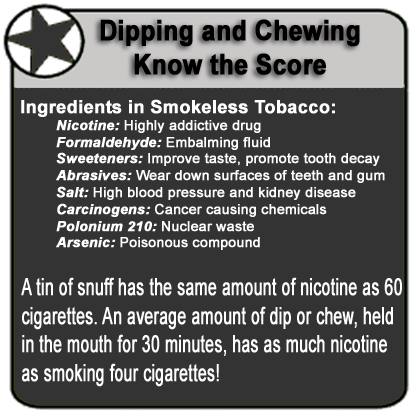
- Strokes
- Nicotine, the drug that makes tobacco
addictive, goes to your brain very quickly.
- Nicotine makes you feel good when you are
smoking, but it can make you anxious, nervous,
moody, and depressed after you smoke.
- Using tobacco can cause headaches and
dizziness.
- Mouth:
- Tobacco stains your teeth and gives you bad
breath.
- Tobacco ruins some of your taste buds, so
you won't be able to taste your favorite foods
as well.
- Tobacco causes bleeding gums (gum disease)
and cancers of the mouth and throat.
- Smokeless tobacco users are fifty times
more likely to develop oral cancers than
nonusers.
- Skin:
- Smoking causes dry, yellow skin and
wrinkles.
- The smell sticks to your skin.
- Muscles:
- Less blood and oxygen flows to your muscles,
which causes them to hurt more when you exercise
or play sports.
- Blood Vessels and Extremities:
- Peripheral vascular disease and hypertension
(high blood pressure)
- Being a vasoconstrictor (constricts blood
vessels), nicotine reduces circulation in
extremities causing them to feel cold
- Environmental Tobacco
Smoke:
- ETS or Environmental Tobacco Smoke includes two
categories:
- Mainstream Smoke:
- The smoke directly inhaled by the smoker.
- Secondhand Smoke:
- The combination of “side-stream” smoke (the
smoke given off by a burning tobacco product)
and “mainstream” smoke (the smoke exhaled by a
smoker)
- Dangers of Secondhand Smoke:
- Among the more than 7,000 chemicals that have
been identified in secondhand tobacco smoke, at
least 250 are known to be harmful.
- Inhaling secondhand smoke causes lung cancer in
nonsmoking adults.
- Approximately 3,000 lung cancer deaths
occur each year among adult nonsmokers in the
United States as a result of exposure to
secondhand smoke.
- Some research suggests that secondhand smoke
may increase the risk of:
- Breast cancer, nasal sinus cavity
cancer, and nasopharyngeal cancer in adults
- Leukemia, lymphoma, and brain tumors in
children.
- Exposure to secondhand smoke irritates the
airways and has immediate harmful effects on a
person’s heart and blood vessels.
- It may increase the risk of heart disease by
an estimated 25 to 30 percent.
- In the United States, secondhand smoke is
thought to cause about 46,000 heart disease
deaths each year.
- Children exposed to secondhand smoke are at
increased risk of sudden infant death syndrome, ear
infections, colds, pneumonia, bronchitis, and more
severe asthma.
- Being exposed to secondhand smoke slows the
growth of children’s lungs and can cause them to
cough, wheeze, and feel breathless.
|
|
|
A Snapshot of Annual High-Risk College
Drinking Consequences From collegedrinkingprevention.gov:
The consequences of excessive and underage drinking affect
virtually all college campuses, college communities, and college
students, whether they choose to drink or not.
- Death: 1,825 college students between the ages
of 18 and 24 die from alcohol-related unintentional injuries,
including motor vehicle crashes (Hingson et al., 2009).
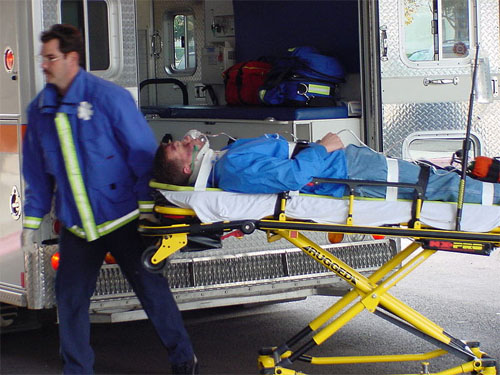
- Injury: 599,000 students between the ages of 18 and 24 are
unintentionally injured under the influence of alcohol (Hingson et
al., 2009).
- Assault: 696,000 students between the ages of
18 and 24 are assaulted by another student who has been drinking (Hingson
et al., 2009).
- Sexual Abuse: 97,000 students between the ages
of 18 and 24 are victims of alcohol-related sexual assault or date
rape (Hingson et al., 2009).
- Unsafe Sex: 400,000 students between the ages
of 18 and 24 had unprotected sex and more than 100,000 students
between the ages of 18 and 24 report having been too intoxicated to
know if they consented to having sex (Hingson et al., 2002).
- Academic Problems: About 25 percent of college
students report academic consequences of their drinking including
missing class, falling behind, doing poorly on exams or papers, and
receiving lower grades overall (Engs et al., 1996; Presley et al.,
1996a, 1996b; Wechsler et al., 2002).
- Health Problems/Suicide Attempts: More than
150,000 students develop an alcohol-related health problem (Hingson
et al., 2002), and between 1.2 and 1.5 percent of students indicate
that they tried to commit suicide within the past year due to
drinking or drug use (Presley et al., 1998).
- Drunk Driving: 3,360,000 students between the
ages of 18 and 24 drive under the influence of alcohol (Hingson et
al., 2009).
- Vandalism: About 11 percent of college student
drinkers report that they have damaged property while under the
influence of alcohol (Wechsler et al., 2002).
- Property Damage: More than 25 percent of
administrators from schools with relatively low drinking levels and
over 50 percent from schools with high drinking levels say their
campuses have a "moderate" or "major" problem with alcohol-related
property damage (Wechsler et al., 1995).
- Police Involvement: About 5 percent of 4-year
college students are involved with the police or campus security as
a result of their drinking (Wechsler et al., 2002), and 110,000
students between the ages of 18 and 24 are arrested for an
alcohol-related violation such as public drunkenness or driving
under the influence (Hingson et al., 2002).
- Alcohol Abuse and Dependence: 31 percent of
college students met criteria for a diagnosis of alcohol abuse and 6
percent for a diagnosis of alcohol dependence in the past 12 months,
according to questionnaire-based self-reports about their drinking
(Knight et al., 2002).
Drunk Driving Statistics from Mothers Against
Drunk Driving (madd.org):
- In 2010, 10,228 people were killed and approximately 350,000
were injured by drunk drivers.
- Each crash, each death, each injury impacts not only the person
in the crash, but family, friends, classmates, coworkers and more.
- Even those who have not been directly touched help pay the $132
billion yearly price tag of drunk driving.
National Smoking Statistics:
- Cigarette smoking causes an estimated 443,000 deaths each year,
including approximately 49,400 deaths due to exposure to secondhand
smoke.
- Economically, more than $96 billion of total U.S. health care
costs each year are attributable directly to smoking.
- Most smokers identify tobacco use as harmful and express a
desire to reduce or stop using it, and nearly 35 million want to
quit each year.
- More deaths are caused each year by tobacco use than by all
deaths from human immunodeficiency virus (HIV), illegal drug use,
alcohol use, motor vehicle injuries, suicides, and murders combined.
- Smoking causes an estimated 90% of all lung cancer deaths in men
and 80% of all lung cancer deaths in women.
- An estimated 90% of all deaths from chronic obstructive lung
disease are caused by smoking.
- Compared with nonsmokers, smoking is estimated to increase
the risk of:
- Coronary heart disease by 2 to 4 times
- Stroke by 2 to 4 times
- Men developing lung cancer by 23 times
- Women developing lung cancer by 13 times
- Dying from chronic obstructive lung diseases (such as chronic
bronchitis and emphysema) by 12 to 13 times.
- In 2009, approximately 20.6 percent of U.S. adults were
cigarette smokers.
- Nearly 20 percent of high school students smoke cigarettes.
- An estimated 9 percent of high school students use smokeless
tobacco.
|
| Thoughts for Living |
 |
|
Smokefree.gov, a product of the National Cancer Institute and the
National Institutes of Health, is a Website designed to help you or
someone you care about quit smoking. Different people need different
resources as they try to quit. The information and professional
assistance available on this site can help to support both your
immediate and long-term needs as you become, and remain, a nonsmoker.
Outlined below is an overview of the Quit Guide located at
smokefree.gov. Click here for
full details: |
- Quit Guide: Thinking About
Quitting
- Think about why you want to quit Decide for sure
that you want to quit. Promise yourself that you'll do
it. It's okay to have mixed feelings. Don't let that
stop you. There will be times every day that you don't
feel like quitting. Stick with it anyway!
- Find reasons to quit that are important to you.
Think of more than just health reasons. For example:
- How much money you'll save by not buying
cigarettes
- The time you'll have for yourself instead of
taking cigarette breaks, rushing out to buy a pack,
or searching for a light
- Not being short of breath or coughing as much
- Setting a better example for your children
- Write down all the reasons why you want to quit, and
list ways to fight the urge to smoke.
- Keep your list where you'll see it often. Good
places are:
- Where you keep your cigarettes
- In your wallet or purse
- In the kitchen
- In your car
- When you reach for a cigarette you'll find your
list. It will remind you why you want to stop.
- Quit Guide: Preparing to
Quit
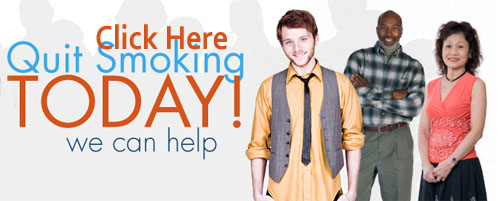
- Just thinking about quitting may make you anxious.
But your chances will be better if you get ready first.
- Quitting works best when you're prepared, thus,
before you quit, START by taking these
five important steps:
- S = Set a quit date.
- T = Tell family, friends,
and coworkers that you plan to quit.
- A = Anticipate and plan for
the challenges you'll face while quitting.
- R = Remove cigarettes and
other tobacco products from your home, car, and
work.
- T = Talk to your doctor
about getting help to quit.
- Quit Guide: Quitting
- Today's the day you start your smoke-free life!
Remind your family and friends that today is your quit
date, and ask them to support you during the first few
days and weeks, they can help you through the rough
spots.
- Using your support program:
- If you decided to use a support program, use
it fully. Go to the sessions. Call your
telephone quit-line, 1-800-QUIT-NOW
(1-800-784-8669). Visit your Internet site. The
more support you get, the more likely you will
quit for good.
- Are you using medicine to help you quit? If
so, follow the directions. If you don't, you're
more likely to go back to smoking. Also, don't
rush to stop using the medicine. Stick with it
for at least 12 weeks. Or follow your doctor's
advice.
- Keep busy:
- Keep very busy today.
- Go to a movie.
- Exercise.
- Take long walks.
- Go bike riding.
- Spend as much free time as you can where
smoking isn't allowed. Some good places are
malls, libraries, museums, theaters, department
stores, and places of worship.
- Do you miss having a cigarette in your hand?
Hold something else. Try a pencil, a paper clip,
a marble, or a water bottle.
- Do you miss having something in your mouth?
Try toothpicks, cinnamon sticks, lollipops, hard
candy, sugar-free gum, or carrot sticks.
- Drink a lot of water and fruit juice. Avoid
drinks like wine and beer. They can trigger you
to smoke.
- Stay Away from What Tempts You
- Instead of smoking after meals, get up from
the table. Brush your teeth or go for a walk.
- If you always smoke while driving, try
something new: Listen to a new radio station or
your favorite music. Take a different route. Or
take the train or bus for a while, if you can.
- Stay away from things that you connect with
smoking. Do it today and for the next few weeks.
These may include:
- Watching your favorite TV show
- Sitting in your favorite chair
- Having a drink before dinner
- Do things and go places where smoking is not
allowed. Keep this up until you're sure that you
can stay smoke-free.
- Remember, most people don't smoke. Try to be
near nonsmokers if you must be somewhere you'll
be tempted to smoke, for example at a party or
in a bar.
- Quit Guide: Staying Quit
- Sticking with it and beating an addiction to
nicotine takes a lot of willpower and determination. You
should feel great about yourself for making it so far.
Now's the time to focus on sticking with it.
- Keeping Your Guard Up
- Your body has changed since you began to
smoke. Your brain has learned to crave nicotine.
So certain places, people, or events can trigger
a strong urge to smoke, even years after
quitting. That's why you should never take a
puff again, no matter how long it has been since
you quit.
- At first, you may not be able to do things
as well as when you were smoking. Don't worry.
This won't last long. Your mind and body just
need to get used to being without nicotine.
- After you've quit, the urge to smoke often
hits at the same times. For many people, the
hardest place to resist the urge is at home. And
many urges hit when someone else is smoking
nearby. Look at your
Craving
Journal (PDF) to see when you might be
tempted. Then use the skills you've learned to
get through your urges without smoking.
- Fighting The Urges
- Click on the Smokefree.gov tips below to
help you fight the urge to smoke.
- Staying Upbeat
- As you go through the first days and weeks
without smoking, keep a positive outlook. Don't
blame or punish yourself if you do have a
cigarette. Don't think of smoking as "all or
none." Instead, take it one day at a time.
Remember that quitting is a learning process.
- Keep Rewarding Yourself For Not Smoking
|
 |
|









